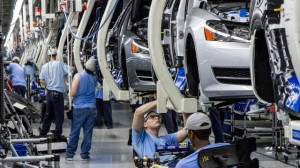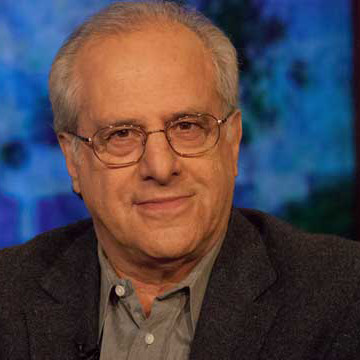“…we’re outraged by politicians and outside special interest groups interfering…” — UAW Secretary-Treasurer Dennis Williams
Many factors led to the United Auto Workers’ (UAW’s) loss in the recent union election at the Volkswagen (VW) factory in Tennessee. Likewise many lessons can be learned. One especially important lesson concerns how one factor – “outside influence” – works so one-sidedly in the United States.
Several UAW spokespersons and supporters bemoaned “outside interference” in this election. It was chiefly Republican politicians and activists and business groups that tried actively to persuade VW workers to vote against unionizing the factory, while the VW management remained neutral. Yet outside interference always influences union elections. Outcomes are never results merely of what employers and employees say and do in election campaigns.

Workers assemble Volkswagen Passat sedans at the German automaker's plant in Chattanooga, Tennessee. (Photo by Erik Schelzig, file/AP)
Just as important is the way workers see the larger world and their places within it. That emerges from the workers’ families and households, the education they received, the mass media they engage, and from political parties and government. All their life experiences shape how they think about everything including voting in union elections.
Organizations of business, the wealthy and the conservatives (think tanks, foundations, hired public relations firms, advertising enterprises, major newspapers, mass radio and TV stations, internet outlets and social media) work constantly to shape workers’ life experiences and thus how they see the world. Because of their dependence on financing from businesses and the wealthy, most Republicans and Democrats avoid conflicts with their campaigns to shape public opinion. Conservatives pander to them.
No alternative, different way to see the world similarly surrounds workers in their daily lives. Workers’ organizations (unions, think tanks, independent media) are many fewer, poorer and much weaker. “Outside influences” shape workers’ consciousness one-sidedly because of the gross disparity of resources available to those exerting that influence. What made local Republicans and conservatives’ billboards persuasive was public opinion; the shape of that opinion defeated unionization in Tennessee. How differently “outside influences” work in other countries is suggested by this simple fact: virtually all of VW’s 105 factories elsewhere are unionized.
The history of unionization in the US reinforces the point. During the middle 1930s, millions joined unions for the first time: the greatest unionization drive in history. We had never seen anything like it before, nor have we since. Unionization then was achieved by a remarkable alliance: unions (allied in the Congress of Industrial Organizations or CIO) plus large, active socialist and communist parties. Those parties widely and effectively contested the “outside influences” stemming from business, the wealthy and conservatives. Socialists and communists mobilized their own media, writers, artists and academics into play. Their demonstrations on many social issues made news and their organizations disseminated a distinctive interpretation of that news. They contradicted what business, the wealthy and conservatives asserted and not only around particular issues. Many among them also contested the economic system arguing that the US could and should do better than capitalism. Interested teachers, clergy, students, immigrant and racial minorities and the general public thus continuously encountered perspectives other than those of business, the wealthy and conservatives.
How workers thought about and responded to union activists in the 1930s reflected the “outside influences” stemming from their socialist and communist allies. Those influences helped to make unionization so stunningly successful then.
Consider the claim – evidently somewhat effective in Chattanooga – that high wages won by the UAW caused Detroit’s economic collapse. That the UAW’s enemies would make that claim is not remarkable; that some workers took it seriously is. Every significant decision at Ford, General Motors and Chrysler since their beginnings was made exclusively by their major shareholders and boards of directors, all small handfuls of individuals. They alone decided what vehicles and fuel efficiencies to produce, what technologies to use, how many workers to hire, and where to locate or relocate factories (north, south, at home, or abroad). They always excluded workers from participation in those decisions (and opposed the UAW’s participation in wage decisions). They insisted on management prerogatives and expertise and corporate responsibilities.
While Detroit’s auto industry was booming, those decision-makers took full credit; it was all about their entrepreneurial geniuses. Then, their many bad corporate decisions (on auto design, technical composition, fuel efficiency, marketing and much else) badly weakened the industry. That plus far better decisions among European, Japanese and Korean auto producers reduced US firms’ profits and market shares. US firms’ major shareholders and boards of directors then decided to leave Detroit, ignoring their decision’s disastrous effects. In contrast, while German manufacturers pay their unionized workers much more than their US counterparts, they have not abandoned their workers or their cities. Germany has no equivalent of Detroit.
As Detroit declined, auto-company decision-makers conveniently reversed themselves and asserted their non-responsibility. They were suddenly not the powerful “captains of industry” they once called themselves. Instead they want folks to believe that the UAW forced high wages on them and that they left Detroit because the UAW victimized them. Some Tennessee workers found such assertions plausible and voted accordingly. By contrast, the profound impact of German unions and their socialist and communist allies on public opinion there helps explain why this year VW’s unionized German workers are enjoying a 5.6 percent wage increase at a time of 1.2 percent inflation.
Only a sustained counterprogram of mass education could at least partly shift “public opinion” so that it functions less as an anti-union “outside interference.” The construction today of an alliance parallel to the one that proved successful in the 1930s might accomplish that counterprogram. Labor needs to rebuild collaborations with academics – students as well as teachers – and political activists who understand past and present contrary to the claims promoted by business, the wealthy and conservatives. In short, a besieged labor movement needs again to become part of a much broader social movement. This time the urgency is less to grow (as in the 1930s) and more a matter of organized labor’s survival.


